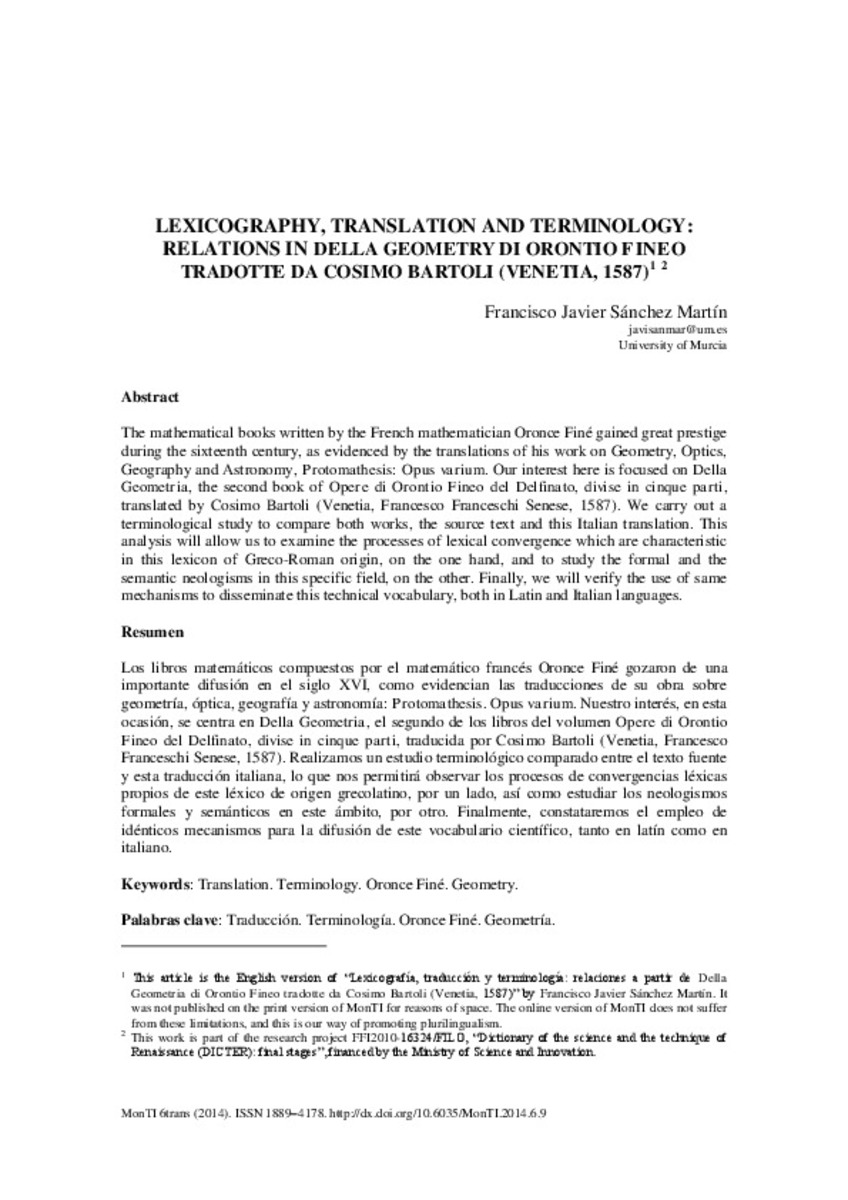Mostrar el registro sencillo del ítem
Lexicography, translation and terminology: relationships derived from Della Geometria di Orontio Fineo tradotte da Cosimo Bartoli (Venetia, 1587)
| dc.contributor.author | Sánchez Martín, Francisco Javier | |
| dc.date.accessioned | 2015-01-16T12:32:23Z | |
| dc.date.available | 2015-01-16T12:32:23Z | |
| dc.date.issued | 2014 | |
| dc.identifier.issn | 1889-4178 | |
| dc.identifier.issn | 1989-9335 (electrònic) | |
| dc.identifier.uri | http://hdl.handle.net/10234/112559 | |
| dc.description.abstract | The mathematical books composed by the French mathematician Oronce Finé gained a great prestige in the sixteenth century, as evidenced by the translations of his work about Geometry, Optics, Geography and Astronomy, Protomathesis: Opus varium. Now, our interest is focused on Della Geometria, the second book of Opere di Orontio Fineo del Delfinato, divise in cinque parti, translated by Cosimo Bartoli (Venetia, Francesco Franceschi Senese, 1587). We carry out a terminological study to compare both works, the source text and this Italian translation. This analysis allows us to examine the processes of lexical convergence which are characteristic in this lexicon of Greco- Roman origin, on the one hand, and to study the formal and the semantic neologisms in this specific field, on the other. Finally, we will verify the use of the same mechanisms to disseminate this technical vocabulary, both in Latin and Italian. | ca_CA |
| dc.description.abstract | Los libros matemáticos compuestos por el matemático francés Oronce Finé gozaron de una importante difusión en el siglo XVI, como evidencian las traducciones de su obra sobre geometría, óptica, geografía y astronomía: Protomathesis. Opus varium. Nuestro interés, en esta ocasión, se centra en Della Geometria, el segundo de los libros del volumen Opere di Orontio Fineo del Delfinato, divise in cinque parti, traducida por Cosimo Bartoli (Venetia, Francesco Franceschi Senese, 1587). Realizamos un estudio terminológico comparado entre el texto fuente y esta traducción italiana, lo que nos permitirá observar los procesos de convergencias léxicas propios de este léxico de origen grecolatino, por un lado, así como estudiar los neologismos formales y semánticos en este ámbito, por otro. Finalmente, constataremos el empleo de idénticos mecanismos para la difusión de este vocabulario científico, tanto en latín como en italiano. | ca_CA |
| dc.description.sponsorShip | This work is part of the research project FFI2010-16324/FILO, “Dictionary of the science and the technique of Renaissance (DICTER): final stages”, financed by the Ministry of Science and Innovation. | ca_CA |
| dc.format.mimetype | application/pdf | ca_CA |
| dc.language.iso | eng | ca_CA |
| dc.publisher | Universitat Jaume I | ca_CA |
| dc.publisher | Universitat de València | ca_CA |
| dc.publisher | Universitat d' Alacant | ca_CA |
| dc.relation.isPartOf | MonTI, 2014, núm. 6 | ca_CA |
| dc.rights.uri | http://creativecommons.org/licenses/by/4.0/ | * |
| dc.subject | Translation | ca_CA |
| dc.subject | terminology | ca_CA |
| dc.subject | geometry | ca_CA |
| dc.subject | Traducción | ca_CA |
| dc.subject | terminología | ca_CA |
| dc.subject | Oronce Finé | ca_CA |
| dc.subject | Geometría | ca_CA |
| dc.title | Lexicography, translation and terminology: relationships derived from Della Geometria di Orontio Fineo tradotte da Cosimo Bartoli (Venetia, 1587) | ca_CA |
| dc.title.alternative | Lexicografía, traducción y terminología: relaciones a partir de Della Geometria di Orontio Fineo tradotte da Cosimo Bartoli (Venetia, 1587) | ca_CA |
| dc.type | info:eu-repo/semantics/article | ca_CA |
| dc.identifier.doi | http://dx.doi.org/10.6035/MonTI.2014.6.9 | |
| dc.rights.accessRights | info:eu-repo/semantics/openAccess | ca_CA |
Ficheros en el ítem
Este ítem aparece en la(s) siguiente(s) colección(ones)
-
MonTi_ 2014 _núm 6 [16]








